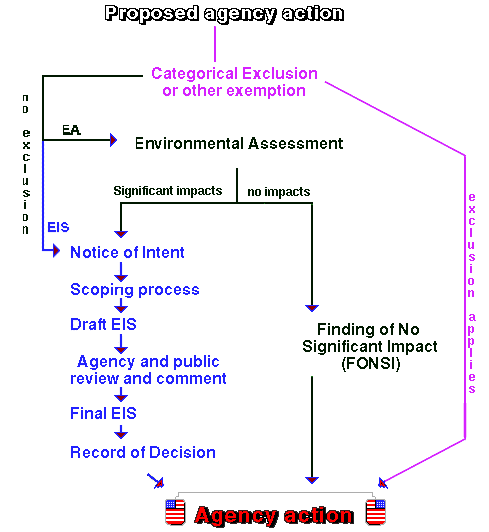|  NEPA NEPA
|
|
Much, if not all, of what Reclamation does
requires some form of compliance with National Environmental
Policy Act ( NEPA ) and associated Council of
Environmental Quality (CEQ) ) and associated Council of
Environmental Quality (CEQ)  regulations. Thus, it is important to
be aware of NEPA requirements. Considerable time and expense
will be saved in solving problems if along the way you frequently
ask "How does NEPA fit here?" or "Will this action (or data)
also help fulfill NEPA requirements?" regulations. Thus, it is important to
be aware of NEPA requirements. Considerable time and expense
will be saved in solving problems if along the way you frequently
ask "How does NEPA fit here?" or "Will this action (or data)
also help fulfill NEPA requirements?"
NEPA is designed to foster excellent decisions, based on
considering the human environment.
NEPA/CEQ encourages public participation by requiring notices
of intent, review periods, and public hearings for environmental
impact statements. This provides a good starting place for balanced
decisions. However, simply following the letter of NEPA/CEQ
requirements will not be enough for an effective problem-solving
effort.
|
|
|  Questions Questions
|
|
The Federal NEPA compliance process must consider the
following overall questions:
- What changes are needed to fulfill the program goals?
- What essential needs must be achieved, irrespective of
all other factors, to achieve final acceptance?
- What are the resource management objectives?
- How will resource management change?
- What can we change to meet the program goals? How will
these changes affect the system and the environment (human,
biological, etc.)?
- What are the legal and institutional changes?
- What study and monitoring requirements (both short and
long term) will provide the information needed to show impacts?
- What legal requirements and agreement requirements that
must be met.
- Who will be affected by a given alternative and how will
they be affected?
- How does each element affect other elements?
- What will cumulative impacts be -- how will practices
affect species, socioeconomics?
|
|
|  NEPA Documents and Decision Process Steps NEPA Documents and Decision Process Steps
| 
|
| Knowledge of environmental integrity
(either through you or someone on your team) and concern
for a sustainable environment will enable you to proceed
with the responsible decisionmaking. You may also be able
to influence others regarding the principles of sustainable
resource management and development. environment will enable you to proceed
with the responsible decisionmaking. You may also be able
to influence others regarding the principles of sustainable
resource management and development. |
| 
|
|
|
The decision process we describe here fits
well within actions required by NEPA/CEQ.
In fact, documents and actions required by NEPA/CEQ are good
tools for problem solving even if your problem-solving effort
does not require NEPA/CEQ compliance. Scoping
helps determine needs, objectives, resources and constraints,
potential options, and requirements for screening criteria.
Public participation also helps find and develop alternatives.
The NEPA process requires various documents to help ensure
a thorough, well thought out process. The figure on the next
page presents a capsulized overview of the NEPA documents and
process. Categorical exclusions are the first step in the process
to decide whether or not the action is significant enough to
warrant a full scale environmental assessment
(EA) . The EA process then helps determine if an action will
have a significant impact. If not, a Finding
of No Significant Impact (FONSI) . The EA process then helps determine if an action will
have a significant impact. If not, a Finding
of No Significant Impact (FONSI) is prepared and decisionmakers decide
whether or not to continue. If so, then an environmental
impact statement (EIS) is prepared and decisionmakers decide
whether or not to continue. If so, then an environmental
impact statement (EIS) helps decisionmakers weigh
those impacts for a balanced decision. Notices of intent, scoping
processes, and periods for review and comment help order public
participation. helps decisionmakers weigh
those impacts for a balanced decision. Notices of intent, scoping
processes, and periods for review and comment help order public
participation.
An EA or an EIS can reflect the results of the decision
process very easily. The format assigns different tasks or steps
to various chapters so the reader can understand the
analysis . The following table compares the format
of an EA and EIS. . The following table compares the format
of an EA and EIS.
|
|
|  NEPA Flow Chart NEPA Flow Chart
|
|
The following image shows the basic requirements
for NEPA documents. Note that the process is NOT just in one
direction. While doing a lower level of compliance (e.g., an
environmental assessment or a categorical exclusion) if you
find you need more investigation and review, you can go to a
higher level (e.g., an environmental impact statement).

|
|